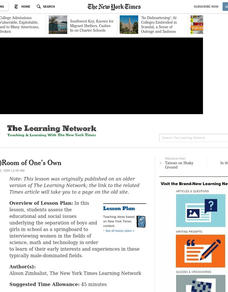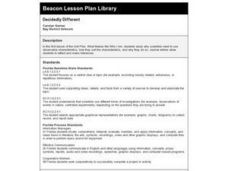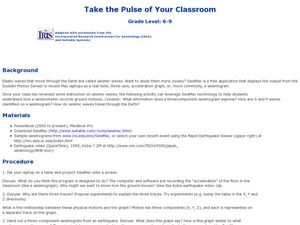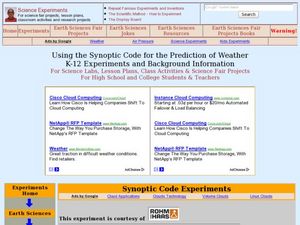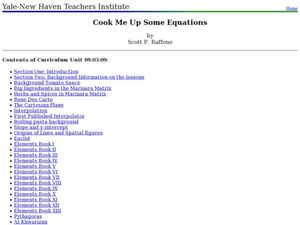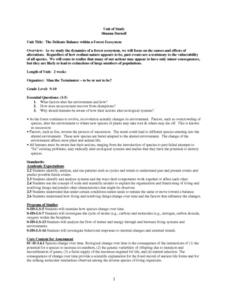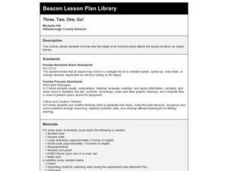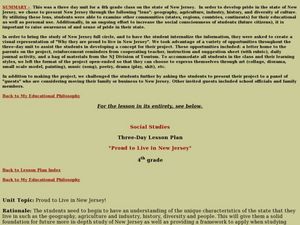Curated OER
The Egg Activity
Students comprehend the three basic steps of science: 1) Observation, 2) Statements of cause and effect (Hypotheses), and 3) Testing. By working with an egg, students are required to observe an object that is very common to them. This...
Curated OER
The Poetry of Chinoiserie
Students study Asian works of art and Japanese haiku. They then take this knowledge and create an original haiku in response to other works of art.
Curated OER
Native Plant Research Project
Students study indigenous plants. They examine why they are special, why some might be threatened, by what forces (pollution, habitat destruction), and what else relies on the continued existence of these plants (insects, animals). They...
Curated OER
A (Class)Room of One's Own
Students assess the educational and social issues of boys and girls in school as a springboard to interviewing women in the fields of science, in order to study of their early interests and experiences in these typically male-dominated...
Curated OER
Decidedly Different
Fifth graders inquire as to why scientists use observable characteristics, how they sort the characteristics, and why they do so. They write journal entries to be used throughout this unit.
Curated OER
Managing Wildlife
Students explore the relationship between wildlife and humans in northern New England. They also brainstorm ideas on why they think some species are greater in population than others in a given area.
Curated OER
Retiring Helicopters
Students discover how helicopters work through an interactive program. They also examine why helicopters are more difficult to fly than airplanes. They discover the history of the helicopter and how it has been used in military operations.
Curated OER
Reflection, Refraction & Lenses
High schoolers are able to describe what happens to light when it strikes different materials. They describe the law of reflection. Students are able to explain why a mirror froms a virtual image. They are able to describe diffuse...
Curated OER
Pasta Bridges
Students analyze the correct use of technology as it relates to math and science. In this science lesson, students investigate force and weight as it relates to building an object. They build a bridge and draw conclusion based on the...
Curated OER
Take the Pulse of Your Classroom
Students discuss seismic waves. In this science lesson, students investigate the acceleration of the floor in the classroom similar to a seismograph. Students observe a three-component seismogram from an earthquake and determine what it...
Curated OER
Using the Synoptic Code for the Prediction of Water
Students construct a thermoscreen for the experiment. For this earth science lesson, students make observations and interpret them using synoptic codes. They predict the weather based on gathered information.
Curated OER
Attributes of Renewable Energy: From Nanopossibilities to Solar Power
Students explore solar energy, why we use it and how we use it. In this renewable energy lesson students compare active and solar techniques.
Curated OER
Cook Me Up Some Equations
Young scholars study a variety of math concepts in the context of cooking up a meal. In this math lesson, students calculate surface area and volume. They draw and interpret different types of graphs.
Curated OER
The Delicate Balance within a Forest Ecosystem
Students examine the causes and effects of alterations in a forest ecosystem and evaluate how human actions may only seem to have minor consequences, but can lead to extinctions of large numbers of populations. Students produce an...
Curated OER
Hands-On Investigation!
Students read, analyze, and solve a mystery using problem-solving skills. They explore the History Detective website, discuss the difference between clues and red herrings, complete a dot-to-dot sheet, take notes in a detective...
Curated OER
Three, Two, One, Go!
Students work in teams conducting an experiment that demonstrates why the height of an inclined plane affects the speed at which an object travels. They record data on a chart and calculate speed to reveal the results of three trials at...
Curated OER
The True Cost of Coffee
Young scholars examine the economic, health, and environmental risks of a one-crop economy in the developing world. They explain how or why it can be challenging for people of one culture to understand the lifestyle of a different...
Curated OER
Sea and Ice Salinity
Students conduct an experiment. In this salinity lesson, students learn about sea ice, why it is important and how changing amounts can affect the sea. Students conduct an experiment to find out the effects of salinity on the...
Curated OER
2.0 "Water Is Life" Global Water Awareness Mini-Unit (Grades3-5)
Students study the amount of potable water on the Earth. In this water lesson, students examine the amount of potable water as compared to all the water on the Earth. They discuss why many parts of the world do not have access to good...
Curated OER
Let's Light up a Light Bulb
Third graders investigate electricity. In this electricity activity, 3rd graders observe a familiar battery-operated toy and brainstorm reasons why and how the battery works. Students work in pairs to explore batteries,...
Curated OER
Discovering Dinosaurs
Students discuss theories about dinosaurs. In this dinosaurs and fossils lesson, students explore different scientific theories regarding dinosaurs and fossils. Students then come up with their own theories about why dinosaurs went...
Curated OER
Proud to Live in New Jersey
Students explore New Jersey. In this New Jersey social studies lesson, students define vocabulary and participate in activities centered around the agriculture, geography, industry, history, and culture of New Jersey. Students construct...
Curated OER
Star Quest
Learners review the concepts of the branch of science known as astronomy. They discuss stars and constellations and then view the night sky using a portable digital planetarium projector. They identify a variety of constellations using a...
Curated OER
Cancer Causes
Students explore why people get cancer. They explore human cells by taking a close examine their own. take a small sample of the epithelial cells that line the inside of their mouth. They glimpse how scientists investigate inside cells.



